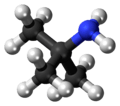tert-Butylamine
| |||
| Names | |||
|---|---|---|---|
| IUPAC name
2-Methylpropan-2-amine[1] | |||
Other names
| |||
| Identifiers | |||
| 75-64-9 | |||
| 605267 | |||
| ChEBI | CHEBI:44639 | ||
| ChEMBL | ChEMBL13782 | ||
| ChemSpider | 6145 | ||
| EC Number | 200-888-1 | ||
| 1867 | |||
| Jmol interactive 3D | Image | ||
| MeSH | tert-butylamine | ||
| PubChem | 6385 | ||
| RTECS number | EO3330000 | ||
| UN number | 3286 | ||
| |||
| |||
| Properties | |||
| C4H11N | |||
| Molar mass | 73.14 g·mol−1 | ||
| Appearance | Colorless liquid | ||
| Odor | fishy, ammoniacal | ||
| Density | 0.696 g/mL | ||
| Melting point | −67.50 °C; −89.50 °F; 205.65 K | ||
| Boiling point | 43 to 47 °C; 109 to 116 °F; 316 to 320 K | ||
| Miscible | |||
| log P | 0.802 | ||
| Vapor pressure | 39.29 kPa (at 20 °C) | ||
| Refractive index (nD) |
1.377 | ||
| Thermochemistry | |||
| 191.71 J K−1 mol−1 | |||
| Std molar entropy (S |
233.63 J K−1 mol−1 | ||
| Std enthalpy of formation (ΔfH |
−151.1–−150.1 kJ mol−1 | ||
| Std enthalpy of combustion (ΔcH |
−2.9959–−2.9951 MJ mol−1 | ||
| Hazards | |||
| Safety data sheet | rose-hulman.edu | ||
| GHS pictograms |    | ||
| GHS signal word | DANGER | ||
| H225, H302, H314, H331 | |||
| P210, P261, P280, P305+351+338, P310 | |||
| EU classification (DSD) |
| ||
| R-phrases | R11, R20/22, R35 | ||
| S-phrases | S16, S26, S36/37/39, S45 | ||
| NFPA 704 | |||
| Flash point | −38 °C (−36 °F; 235 K) | ||
| 380 °C (716 °F; 653 K) | |||
| Explosive limits | 1.7–9.8% | ||
| Lethal dose or concentration (LD, LC): | |||
| LD50 (Median dose) |
464 mg kg−1 (oral, rat) | ||
| Related compounds | |||
| Related alkanamines |
|||
| Related compounds |
2-Methyl-2-nitrosopropane | ||
| Except where otherwise noted, data are given for materials in their standard state (at 25 °C [77 °F], 100 kPa). | |||
| | |||
| Infobox references | |||
tert-Butylamine is an organic chemical compound with the formula (CH3)3CNH2. It is a colorless liquid with a typical amine-like odor. tert-Butylamine is one of the four isomeric amines of butane, the others being n-butylamine, sec-butylamine and isobutylamine.
Preparation
tert-Butylamine is produced commercially by the Ritter reaction of isobutene with hydrogen cyanide under acidic conditions to give the formamide:[2]
- (CH3)2C=CH2 + HCN + H2O → (CH3)3CNHCHO
- (CH3)3CNHCHO + H2O → (CH3)3CNH2 + HCO2H
In the laboratory, it can be prepared by the hydrogenolysis of 2,2-dimethylethylenimine, or via tert-butylphthalimide.[3]
Uses
tert-Butylamine is used as an intermediate in the preparation of the sulfenamides such as N-tert-butyl-2-benzothiazylsulfenamide and N-tert-butyl-2-benzothiazylsulfenimide. As rubber accelerators, these compounds modify the rate of vulcanization or rubber. A variety of pesticides are derived from this amine, including terbacil, terbutryn, and terbumeton.
In pharmacology under the name erbumine, tert-butylamine has been used an an excipient in some drug formulations such as perindopril erbumine.
See also
References
- ↑ "tert-butylamine - Compound Summary". PubChem Compound. USA: National Center for Biotechnology Information. 16 September 2004. Identification and Related Records. Retrieved 7 May 2012.
- ↑ Karsten Eller, Erhard Henkes, Roland Rossbacher, Hartmut Höke "Amines, Aliphatic" in Ullmann's Encyclopedia of Industrial Chemistry, 2000, Wiley-VCH, Weinheim. doi:10.1002/14356007.a02_001
- ↑ Kenneth N. Campbell, Armiger H. Sommers, and Barbara K. Campbell (1955). "tert'-Butylamine". Org. Synth.; Coll. Vol. 3, p. 148


